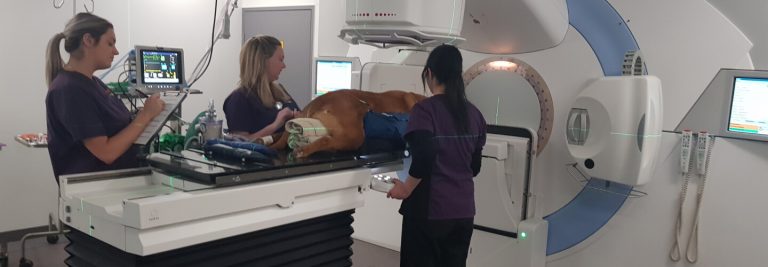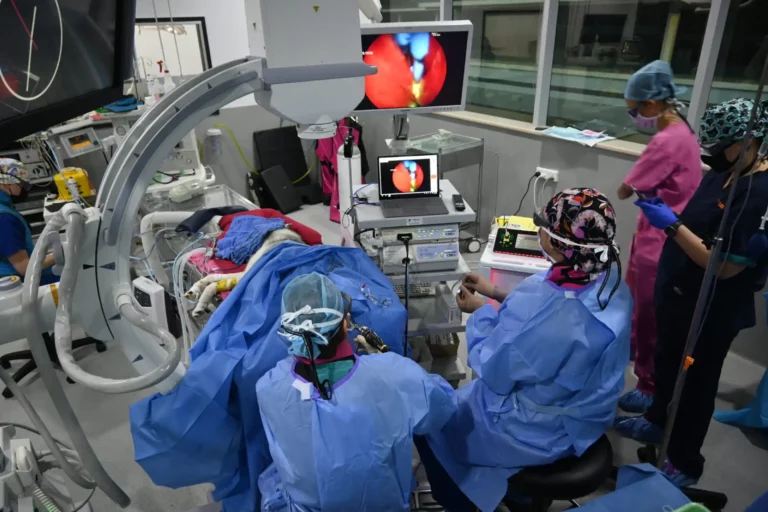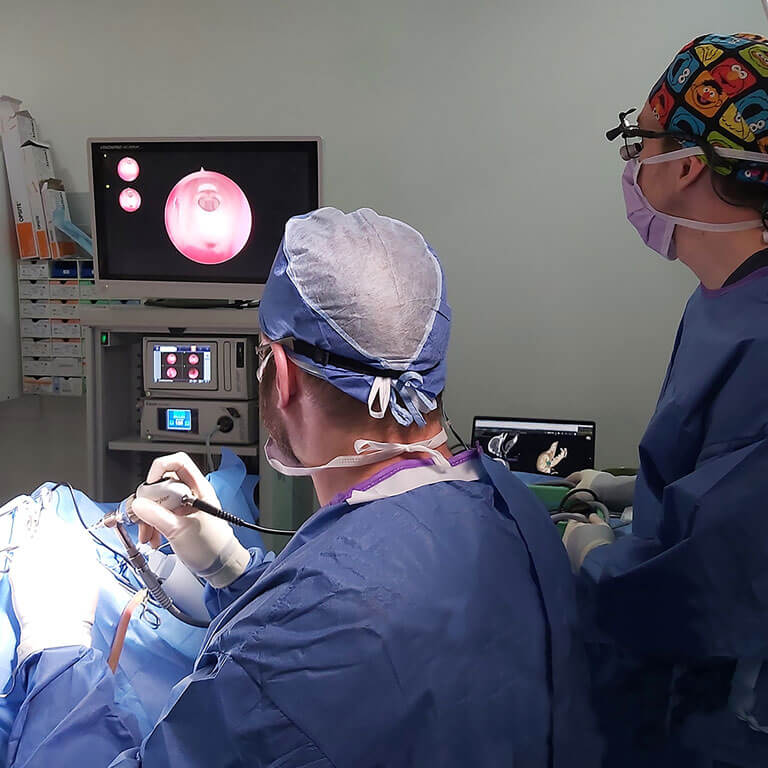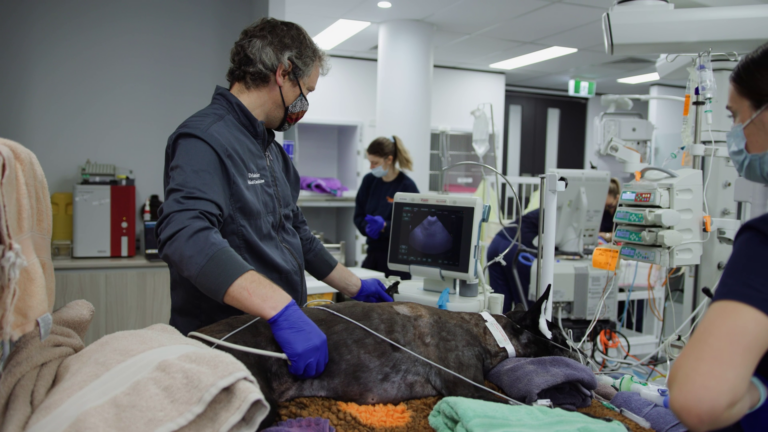Dr Sophia Tzannes
What is IMHA?
IMHA stands for immune mediated haemolytic anaemia. So this is one of the most common immune mediated diseases we see. And it’s referring to the immune system in the dog and the cat inappropriately destroying erythrocytes, and that can cause a haemolytic anaemia. It’s got a fascinating background. We know that it can be a spontaneous disease, as can many autoimmune diseases, but we also recognise it can have triggers. We used to call those secondary IMHA, now we consider them to have triggers for that disease process. We know a bit about the genetics, and that’s really interesting. We learn a bit from our human counterparts, we learn a bit from looking at breed predispositions. And we also can have a look at the haplotypes that are predisposed for this sort of disease.
How do we diagnose IMHA?
It sounds pretty simple. And I suppose despite being fairly logical in the way we approach this disease, it’s actually really challenging, and it can be really frustrating to always make the correct diagnosis. I’m just going to mention that it’s really important to feel comfortable with your diagnosis, because if we do get it wrong, we misdiagnose IMHA, we’re actually committing a patient to unnecessary immunosuppressive treatment and that can have side effects, and also fundamentally we’re missing the cause of that patient’s anemia and so that’s actually going to continue unabated.
So on saying that, how do I diagnose it? I suppose I’m going to approach it just as I would any animal with anemia. So we’re taught at vet school, we’re going to first of all use our PCV or CBC, so hematocrits, we’re going to identify the anaemia, maybe because the patient was symptomatic, maybe from the patient’s history, that’s prompted us to look a bit further. And at that point I’m going to have a look at the severity of the anemia. I’m going to go back to my physical exam, an excellent physical exam is really important.
Because this is IMHA, I’m also going to stress, as with any case, history is essential. I’m going to get clues about anaemia from my history, so I’m going to concentrate particularly on drug history, medicines that that animal has been exposed to. So maybe have a little list of the medicines that can cause anaemia in the back of your mind, and that’s going to help you with really direct questions for your client conversation. Also environment’s really important, and clearly physical exam and signalment will help us put the pieces of the puzzle together.
At that point, I’m going to ask a question to myself, have I got any evidence of regeneration? So for me I’m looking for reticular cytosis. And I am going to say that’s really handy, so if I have a regenerative anaemia I can really start to fine tune my diagnostic differentials. I am just going to mention though, obviously, that about a third of our patients with IMHA come through the door with a non regenerative anaemia. So don’t discount those patients, because we are presenting with a non regenerative anaemia.
So if I’m looking then at my next step for IMHA, I need to really establish two things. I need to establish that we have immune-mediated destruction, so markers for immune-mediated destruction, and we also have to have a look for evidence of hemolysis. So those are the two next steps that we’re interested in. Starting with markers for immune-mediated destruction, some of these are bench side and some of these are going to rely on tests that I’m going to send away.
So my bench side test is going to be what we call the slide agglutination test. So that’s really, really handy, and we have to actually do it in house before we send some blood tests away, and before we use treatment on our patient. It’s as simple as taking a drop of blood and some room temperature saline, and use four drops of room temperature saline, and have a look at your slide for agglutination. That ratio I mentioned is actually the most successful in terms of actually getting our best sensitivity and specificity. That’s one type of marker of immune-mediated destruction.
The second thing we’re going to be looking for is actually antibody production against the red cells. So that’s going to be our direct Coombs test. And the third thing that we’re going to be looking for is spherocytosis on the slide. Now obviously, you can do that yourself in house, but you can also send that away externally. And I do advise that we make a good blood smear and send that away. If you’re doing it in house, have a look at your monolayer, not your thick monolayer or your really thin feathered edge, because artifacts will occur in that area. But in the normal monolayer, that’s where we’re going to get our best success. The numbers matter. And also just don’t forget that cats really don’t get spherocytes so this is really relating to the dog when we make that part of the diagnosis.
So what we’re really looking for here are two markers of immune destruction, and if we have two markers we feel much more confident with our diagnosis. Another option is we actually can get away with one marker, if we’ve got our slide agglutination test that remains positive after repeat washing, which is a little bit more technical and I won’t go into now.
So we’ve got our immune-mediated markers, and now we need to find if we’ve got evidence of hemolysis to make this diagnosis. So what we’re looking for here is hyperbilirubinemia, without another cause for hyperbilirubinemia, I’ll go into that in a minute, hemoglobinemia, hemoglobin in our urine, and if I want to touch back onto the hyperbilirubinemia, as well if we’ve got an icteric animal. Just pausing on the icteric animal, we know that there are other causes for this to occur. So we need to feel confident that we don’t have a cause for extra hepatic obstruction or hepatic disease that might be causing the same symptom. So we’re going to be really relying on other markers in our blood work, and we’re going to be relying on potentially our imaging to rule those sort of things out.
In terms of other, I suppose, problems with that approach, just be careful with hemoglobin. Hemoglobin can obviously accrue from an artifact or a lab error, so you’ve got a less smooth blood draw for instance, or if you’re actually taking blood out of an IV catheter, potentially we recognize that as causing hemolysis.
If we’re confident that we have got markers of hemolysis in an anemic patient without other causes for that hyperbilirubinemia or other parameters to exist, and we’ve got our markers of immune-mediated destruction, we’ve made our diagnosis. Now, in real life, I suppose that’s great. Sometimes we feel very strongly that our patient has IMHA, we’re almost there, we haven’t quite got that strength of evidence. So what we have to do in those cases is really examine our patient. We can call it likely IMHA, and we really potentially have to look carefully for other causes of anemia in that patient to feel more confident in making that diagnosis and more confident in starting treatment.
I’ll just touch briefly on a different presentation of IMHA. It’s actually a type of IMHA that walks through the door that’s non regenerative. And I mentioned earlier that about a third of the cases are going to be non regenerative, and that is either because it takes three to five days for the bone marrow to kick in and start producing the red cells for the regenerative response to be identified, or we’re actually looking at that category of immune mediated disease that our attack is occurring at the level of the bone marrow. And that’s either at the precursors of the erythrocytes or actually at the mature erythrocytes just before they’ve come out into the bloodstream.
And these are the non regenerative IMHA, they’re still a part of the umbrella term. A little bit different because they can present with a slightly different set of symptoms. And our lab testing can be a little bit more complex. We may not see spherocytosis in these individuals, we may not have a direct positive Coombs test. And in those cases we’re really reliant on a bone marrow exam and classic or characteristic cytological or histopath results, plus actually a positive response to immune suppressive treatment. So I’m not probably going to go down that track in depth in this sort of setting, but I just wanted to make a mention of that type of IMHA and the difference in diagnostics for that disease.
What are the recommended next steps?
So what would I do now?
At this point in time, I’m actually looking for triggers for the disease. I mentioned that it can be spontaneous and we don’t have a trigger, or we might identify a trigger for this particular patient. And I’m looking particularly for inflammation, infection, cancer, et cetera. Now, some of the emphasis or the diagnostic workup will be dependent on the patient, the signalment, and some of the history. So for instance, have they used heartworm treatment? Are they up to date with flea and tick treatment? And other things are going to be less specific.
Just to mention about what we know about the triggers, there’s a lot of anecdotal information about many diseases that trigger this. For instance, we know that in people, lymphoproliferitive cancers are a very well known trigger in their population. Whereas in our veterinary population, we recognize it, certainly I’ve had personal experience with an animal with lymphoproliferative disease and IMHA, but the scientific evidence isn’t robust enough yet for us to actually essentially prove that point. So it’s a little bit more about the powers of our study and the powers of about our science rather than actually saying that these aren’t factors to consider. And we know for instance, in a cat there’s probably about 15% of cats with IMHA that actually have an underlying cancer.
There are, on saying that, really specific diseases that we know and have gotten really strong causal evidence for IMHA, and a good example would be in the cat, we’ve got mycoplasma hemofelis, which can actually cause IMHA. So these cats absolutely need a PCR to try and diagnose that infection. For other our animals I mentioned, we’re using common sense. What’s happening in the history? What’s their signalmet? Are we worried about cancer in these individuals? And we’re screening for those diseases. Fundamentally, we know we’re going to get a poor treatment outcome if we don’t identify those secondary triggers. And obviously it’s really important for us to maximize that success. What does that look like? It looks like imaging, so thoracic and abdominal imaging. We’re also going to pick up more on ancillary blood tests, for instance, and other diagnostics, depending on the patient individual.
Tell us about treatment?
Okay, so treatment for IMHA. First of all, to answer that question, we have to understand, what do our patients die from? We lose probably up to a third of our patients in that first two weeks after our diagnosis. We’re losing them because of tissue hypoxia and organ failure, so that’s secondary to the anemia. And we’re also losing them commonly to thromboembolic disease. And these are the two targets that we really need to concentrate on for our treatment.
Clearly we need to stop the immune attack, which is causing the anemia. So that’s our first line. But I also mentioned the importance of tissue hypoxia and the effect on organs and systemic inflammation associated with the disease. So we may need to consider support products like blood products to try and get us across the line and stabilize our patient. And the third line of treatment I’ve mentioned here is thromboembolic treatment. So we’d want to use something to stop those thromboembolic events.
If I’m going to start with our mainstay, which is immunosuppressive treatment, we have an immune system that’s out of control and we’re trying to actually immunosuppress, and our first line, as we all know, is the drug prednisolone. Why is it first line? First of all, it is the only drug that has got the strongest basis of science behind it. We know it is readily available, inexpensive, and it actually is reliable, and our fastest oral drug that we can give our patients to generally suppress the immune system and that immune attack. We know that steroids have got side effects, so we’re aware of that when we use it on our patients. And I think, just really quickly, we know that it can mask the disease process as we would like it to do. So make sure we’ve got all our diagnostics before we reach for steroids, and that would include actually patients we’re worried about with cancer like lymphoma, to try and grab our samples before we use that drug.
The second lines of drugs we can sometimes use are also immunosuppressive drugs. So this is a little bit more controversial because there is no right or wrong. I commonly use a second line of immunosuppressive drugs, but I’m always making that decision on a patient by patient basis, because there is no scientific evidence that we, when using a second line of drug, will improve our outcome. However, anecdotally, I will say I will use and reach for that second line drug when I’m worried about the steroid side effects will be unacceptable for my patients. So quickly I want something in my back pocket to support this therapeutic control.
And the second time I really am keen to start a second line drug is if I’ve got a really severe presentation. Any drug I’m using has a lag time to effect. Steroids is the shortest lag time, but it’s still a couple of days potentially that I need to wait. So if I’m worried about wasting that time, and I know some of my second line drugs take one to two weeks to kick in, I’m going to start them early. Which drug? Look, certainly in the past I’ve used cyclosporine, azathioprine, mycophenolate mofetil. There are a number of drugs that have been researched for use in this disease and certainly all of them are with their own unique side effects. We need, if we’re using them, to be aware of those side effects. We also need to know inter-drug reactions when to use those drugs. But if we’re confident in using them, they can be really, really helpful. At the moment, so it happens, I do use more cyclosporine, and I’m relying on that as my second line drug.
I’m also always aware of patient and client logistics, because some of these drugs are not as inexpensive as prednisolone. So my mainstay is immunosuppressive treatment. There are other immunosuppressive, I suppose, products that are out there. I used to use a fair bit of human immunoglobulin intravenously as an emergency stop gap, that’s actually not readily available unfortunately at the moment and so that’s not something in our repertoire we have currently.
The second phase of treatment I mentioned was supporting our patients through a crisis and avoiding that tissue hypoxia and that spiral into uncontrolled systemic inflammation. There are a couple of prognostic indicators in this disease that have been very much repeatable in the literature, and that’s actually a high bilirubin and a high urea. Some of these are representing the severity of the disease and also the impact on our whole body, as the body is impacted by anemia. So I’m using blood products reasonably early in particular patients, and what I want to say I suppose is, that there is no magic number. I don’t get to a certain PCV and think, “I have to use a blood product now.” It’s about the whole patient as a whole and the impact that that anemia has on that patient physiologically.
On saying that, there are a couple of numbers that once we drop over that cliff and become very anemic, we know that those patients must be significantly hypoxic and we’ll want to transfuse them. What’s the best product? Well packed red cells are usually the best fit for this disease process because our patients aren’t necessarily dehydrated and hypovolemic. If we don’t have packed red cells and we’d like them to be relatively fresh, because they’re less risky when they’re relatively fresh, we will probably pull out some fresh whole blood as an option. Now, at SASH we’re really, really lucky, we have a wonderful blood bank program. We have fabulous clients and people who are very happy to donate and save lives, and so we have a luxury in the sense that we’ve got blood products to hand. So if you don’t have access to that, consider early referral, because that’s might be a lifesaving option for your patient.
In terms of the third line of attack, I’ve talked about use of antithrombotics as a regular event, and unless we’ve got a patient that’s significantly thrombocytopenic, I’m probably going to use this as a standard. And there are a couple of options available. We used to use a lot of low-molecular-weight heparin. It’s a little bit difficult to monitor closely the impact of using that medicine, but it’s possible to use it safely. The second option for antithrombotic treatment would be using antiplatelet drugs, which I at the moment more commonly use.
So those are my three main ways of treating this disease. I’ve mentioned the prognosis as well, where it’s a serious disease, we lose them in higher numbers than I’d like, but if we are essentially proactive with our treatment, we look for the best fit, and we have very tailored individual patient care, the outcome when they do well is incredibly rewarding.
One little mention, we know that they do relapse, so it’s about a 15% rate of relapse. So client education is key. We need to make sure that they know this is the long haul. We have three to six months of immunosuppressive treatment ahead of us. Monitoring is important. There’s a very small chance of relapse. But most people are pretty committed by that stage and are happy to go down that road.
What are the possible pitfalls with IMHA?
I am going to say there are many. I mentioned initially it’s a challenging disease to diagnose. But I suppose I want to just touch on a few. I think a key thing for me is, let’s aim to maximize our diagnostics. So straight off, I’d love people to grab samples that will be useful down the track. Make that blood smear, look for spherocytes. Don’t just look in house, send that away to an external pathologist to avoid misinterpretation. And recognize also that if we’re not sure, taking the blood now to actually blood type in case we need a blood donation, also to potentially look for a Coombs test, it’s better off to take your samples early and store them and not use them, than never to have taken them at all. Don’t forget some of those tests like Coombs can actually stay stable for three or four days, chat to your lab, and therefore that can be really useful to have in your back pocket.
I mentioned as well, there can be triggers for IMHA, so things like lymphoma, if you’re worried there might be lymphoma, try and take your samples early prior to actually using immunosuppressive treatment, because once you’ve pulled out your steroid, it’s going to be hard to go backwards and make the diagnostics that you need to feel confident in case your treatment is not going to plan, and it’ll be hard to actually look for underlying triggers. Use common sense. If you don’t have the facilities to actually look for some of those diseases and it’s lifesaving to use steroids, grab yours samples, use some steroids, and call out for help.
A second pitfall might be also to do with actually diseases that mimic IMHA. I haven’t really talked about all the diseases that cause hemolysis, so a hemolytic anemia that’s not actually to do with immune-mediated attack, and there are a number of diseases we know about, so familiarize yourself with those. Make sure your history has targeted any of those risk factors that might actually reveal that this is not an immune-mediated process, and therefore it would be wrong to potentially use immunosuppressive treatment.
Something that comes to mind. So for instance, hemangiosarcoma, which can actually cause microangiopathic hemolysis, we’re still going to get that cell fragmentation and we still may say spherocytes. So that’s not necessarily pathagnomonic for IMHA. I don’t forget those criteria. We need strong diagnostic criteria to come together to strengthen our diagnosis. Look, therefore, in those cases for other clues of fragmentation. So look for other things like schistocytes, for instance, or keratocytes. Talk to your lab people, talk to us if you’re not sure.
The other thing which is completely invaluable at this point is imaging. So fabulous diagnostic imaging can make a difference with some of these trickier diagnostics and trickier patients to diagnose. One of the other things, similarly, would be occult bleeding in the intestinal tract, and again that’s really tough and it can mimic IMHA. Look for your proteins. Look for other things in your blood work that can actually help you define which one is gut loss and which one is actually hemolysis. Use your imaging as a tool.
One of the other pitfalls to mention might be that our tests are imperfect. I’ve touched on spherocytes being positive in another disease. There are some patients with true IMHA that may not have positive tests such as the markers of immune-mediated disease. I mentioned non regenerative IMHA. So we have to look globally at the big picture.
Another mimicking disease, which is unusual but we see it, is disseminated histiocytic sarcoma. It looks almost identical. So we’re, again, looking for some of the key features that can actually help us tell them apart. So if you’re not sure, please reach out and get some opinions. Again, what’s key is great diagnostic imaging, a great interpretation of the patient and their particular pathology, and grabbing those diagnostic tests early before we’ve changed the picture. I mentioned, grab blood for blood typing, that’s another pitfall that we see, because we love early use of blood products, and that can be a life saving tool that we have for these patients. So if you’re feeling that this is possibly a patient that will benefit from transfusion, if you can send it, promptly grab some blood first, and that can make the difference in the outcome for these patients.




